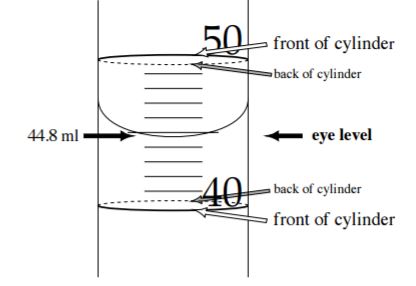Graduated Cylinders - Science Lab Equipment

As the name suggests, the graduated cyliner is cylindrical, tall, and narrow. Cylinders have marked lines designating the amount of a solution in the cylinder. A graduated cylinder can make moderately precise measurements of volumes.
Graduated cylinders will keep your lab work precise. This piece of equipment is normally made of polypropylene or glass and designed to measure the volume of a liquid and for fluid preparations.Buy Graduated Cylinders Online
Common question: Where can I buy a graduated cylinder?
You're probably here because you are looking for where to buy a graduated cylinder online. You've come to the right spot, we compiled and compared the graduated cylinders so that we could create a top selection list of educator-reviewed instruments.
If you need a "set" of cylinders (as most students will), we highly suggest buying a packaged set instead of buying each size individually. These are the two sets we recommend:
The listing's featured product is the ETA hand2mind's set of 7 polypropylene measuring cylinders. The set contains: 10ml, 25ml, 50ml, 100ml, 250ml, 500ml, and 1,000ml. Every cylinder features and easy-pour spout.
5 ml graduated cylinder
People commonly use the 5 ml size for measuring medicine, essential oils, lotions, or other high potency household products.
If you specifically need only the 5 ml size we recommend going with either of following two products. NOTE: If you are using a graduated cylinder for mixing essential oils you need to buy a glass cylinder (like the ones below) because pure oils can melt plastic.
- SEOH Graduated Cylinder Borosilicate Glass 2 Part- Capacity - we were extremely impressed with the quality of this product. Obviously, it is a very small cylinder with many uses.
- KeL Scientific KS-701 5 ml Graduated Glass Cylinder -
10 ml graduated cylinders
Once again, buying in a set is usually the best way to go. However, below are our top choices for the 10 ml sizes. One is glass, the other is plastic.
25 ml graduated cylinder
50 ml graduated cylinder
Our recommendation for a 50 ml that is pure glass:
Karter Scientific 50ml Glass Graduated Cylinder.
Our recommendation for a 50 ml is EISCO's Polypropylene model.
100 ml graduated cylinder
For a glass model we recommend the Karter Scientific 100ml Glass Graduated Cylinder. Made from Borosilicate Glass, these aren't just used for home science experaments, they are used for home brewing, vaping, and much more.
The glass model we recommend: Pixnor 100ml Transparent Plastic.
250 ml graduated cylinder
Buy the Karter Scientific 250ml Glass Graduated Cylinder.
500 ml graduated cylinder
Buy the Karter Scientific 500ml Glass Graduated Cylinder.
1000 ml graduated cylinder
Buy the SEOH Graduated Cylinder - Borosilicate Glass.
More Information About Graduated Cylinders
The most common features near the top of a glass cylinder are bumpers or guard. Either can be used to surround the upper portions of cylinders. When tipped over, these can protect the cylinder from shattering. Any liquid, of course, will still spill.
Another common feature are wide bases. These are used for stability.
Some cylinders have pigment stripes which are added to make measuring easier and more accurate. Mixing cylinders should come with sealable tops and stoppers. If a cylinder is not designed for mixing, it will probably have some type of spout easy pouring. [Source].
Graduated cylinder sizes
As stated earlier, cylinders come in a wide variety of sizes. Cylinders are measured by capacity in milliliters. The standard range for cylinder sizes is 5 ml to 4000 ml.
The full list of cylinder sizes is: 5, 10, 25, 50, 133, 250, 500, 1000, 2000, and 4000.
Common uses for graduated cylinders
Common questeion: What is a graduated cylinder used for in science?
The primary use for graduated cylinders is measuing the volume of a liquid substance. Where does the graduated cylinder fall on a scale of accuracy? Graduated cylinders provide more precise measurements than glassware beakers and flasks. However, cylinders are not as accurate as volumetric flasks or pipettes.
Glass cylinders have a very high tolerance for heat and chemicals. When measuring, students must take care to account for the meniscus. Glass cylinders are often made of plastic because plastic cylinders do not break as easily as glass. Additionally, plastic can be coated to avoid a meniscus.
Dangers and common mistakes while using a graduated cylinder
Always be extremely careful when using a graduated cylinder. Their structure and design make them extremely easy to knock over. Their tall, thin, and narrow design causes them to easily tip. Once they fall, they easily break (especially when made with glass) and their contents will spill everywhere.
Pouring
When you pour the contents of a cylinder, never ever lower yourself so low that your head and eyes are on the same plane as the table top. If an accident occurs and a cylinder slipps, your face will be in the worst possible position. The liquid inside chemistry experaments is almost never something you want in your face or body.
The best practice for pouring is to:
- Put the liquid into a cylinder
- Use one hand to hold it
- Use the other hand to pour the liquid from one container to the other
How to read a graduated cylinder
Common question: How do you read a graduated cylinder?
Reading a graduated cylinder is not too difficult, but there are best practices. The volumes can be measured to 3 significant digits if care is taken. Before reading the solution's volume, the observer should always be at eye-level with the cylinder.
To observe how much liquid is in the cylinder, hold the container up to eye level. Grip the cylinder at the top so that it will hang as vertical/straight as possible. To document the most accurate measurement observe the bottom of the meniscus of the liquid level.

For more information, see this article.












